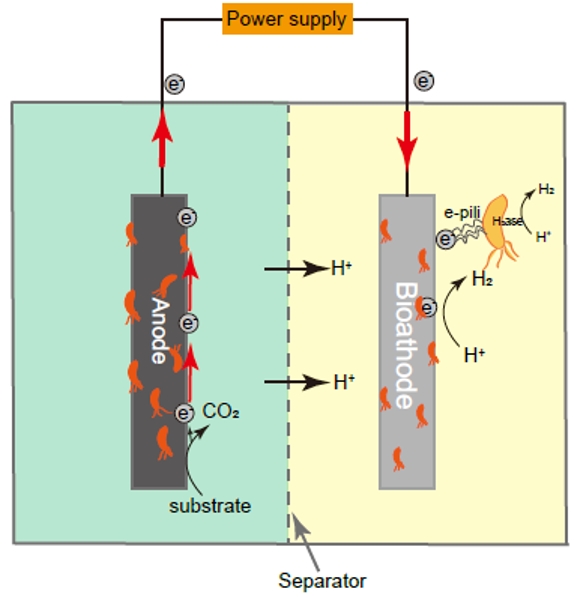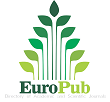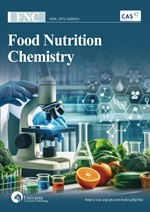Biohydrogen production from saline wastewater: An overview
DOI:
https://doi.org/10.18686/cest.v2i3.210Keywords:
biohydrogen; metabolism; salt stress; microbial adaptation; fermentation; saline wastewaterAbstract
The escalating global demand for sustainable energy has propelled the exploration of biohydrogen production with a promising avenue for simultaneously generating clean energy and managing waste effectively. This review mainly focuses on advances in sustainable biohydrogen production from saline wastewater, especially in a process that leverages the unique abilities of halotolerant and halophilic microorganisms adapted to high-salinity conditions. It provides an extensive understanding of various biohydrogen production methods, which are biophotolysis, photofermentation, dark fermentation, and microbial electrolysis. Additionally, this review elaborated on the enzymology of hydrogen production and the impact of salt stress, with a particular emphasis on the adaptive mechanisms of “salt-in” and “compatible solute” strategies. These adaptations are crucial for maintaining enzymatic activity and structural integrity under hypertonic conditions. Through a comprehensive examination of microbial pathways and strategies, this review aimed to furnish foundational insights that will drive future research and technological innovations in biohydrogen production.

Downloads
Published
How to Cite
Issue
Section
License
Copyright (c) 2024 Huiyuan Guo, Zedong Teng, Hexing Han, Tinggang Li

This work is licensed under a Creative Commons Attribution 4.0 International License.
References
1. Xu X, Zhou Q, Yu D. The future of hydrogen energy: Bio-hydrogen production technology. International Journal of Hydrogen Energy. 2022; 47(79): 33677-33698. doi: 10.1016/j.ijhydene.2022.07.261 DOI: https://doi.org/10.1016/j.ijhydene.2022.07.261
2. Megía PJ, Vizcaíno AJ, Calles JA, et al. Hydrogen Production Technologies: From Fossil Fuels toward Renewable Sources. A Mini Review. Energy & Fuels. 2021; 35(20): 16403-16415. doi: 10.1021/acs.energyfuels.1c02501 DOI: https://doi.org/10.1021/acs.energyfuels.1c02501
3. Zhang Y, Xiao Y, Abuelgasim S, et al. A brief review of hydrogen production technologies. Clean Energy Science and Technology. 2024; 2(1): 117. doi: 10.18686/cest.v2i1.117 DOI: https://doi.org/10.18686/cest.v2i1.117
4. Srivastava A, Parida VK, Majumder A, et al. Treatment of saline wastewater using physicochemical, biological, and hybrid processes: Insights into inhibition mechanisms, treatment efficiencies and performance enhancement. Journal of Environmental Chemical Engineering. 2021; 9(4): 105775. doi: 10.1016/j.jece.2021.105775 DOI: https://doi.org/10.1016/j.jece.2021.105775
5. Adessi A, Concato M, Sanchini A, et al. Hydrogen production under salt stress conditions by a freshwater Rhodopseudomonas palustris strain. Applied Microbiology and Biotechnology. 2016; 100(6): 2917-2926. doi: 10.1007/s00253-016-7291-4 DOI: https://doi.org/10.1007/s00253-016-7291-4
6. Taroepratjeka DAH, Imai T, Chairattanamanokorn P, Reungsang A. Biohydrogen production by extremely halophilic bacteria from the salt pan of Samut Sakhon, Thailand. Chiang Mai Journal of Science. 2020; 47: 378-390.
7. Pierra M, Trably E, Godon JJ, et al. Fermentative hydrogen production under moderate halophilic conditions. International Journal of Hydrogen Energy. 2014; 39(14): 7508-7517. doi: 10.1016/j.ijhydene.2013.08.035 DOI: https://doi.org/10.1016/j.ijhydene.2013.08.035
8. Guo L, Zong Y, Lu M, et al. Effect of different substrate concentrations and salinity on hydrogen production from mariculture organic waste (MOW). International Journal of Hydrogen Energy. 2014; 39(2): 736-743. doi: 10.1016/j.ijhydene.2013.10.127 DOI: https://doi.org/10.1016/j.ijhydene.2013.10.127
9. Cai J, Wang G. Hydrogen production by a marine photosynthetic bacterium, Rhodovulum sulfidophilum P5, isolated from a shrimp pond. International Journal of Hydrogen Energy. 2012; 37(20): 15070-15080. doi: 10.1016/j.ijhydene.2012.07.130 DOI: https://doi.org/10.1016/j.ijhydene.2012.07.130
10. Cai J, Guan Y, Jia T, et al. Hydrogen production from high slat medium by co-culture of Rhodovulum sulfidophilum and dark fermentative microflora. International Journal of Hydrogen Energy. 2018; 43(24): 10959-10966. doi: 10.1016/j.ijhydene.2018.05.014 DOI: https://doi.org/10.1016/j.ijhydene.2018.05.014
11. Mouné S, Manac’h N, Hirschler A, et al. Haloanaerobacter salinarius sp. nov., a novel halophilic fermentative bacterium that reduces glycine-betaine to trimethylamine with hydrogen or serine as electron donors; emendation of the genus Haloanaerobacter. International Journal of Systematic and Evolutionary Microbiology. 1999; 49(1): 103-112. doi: 10.1099/00207713-49-1-103 DOI: https://doi.org/10.1099/00207713-49-1-103
12. Liaw HJ, Mah RA. Isolation and Characterization of Haloanaerobacter chitinovorans gen. nov., sp. nov., a Halophilic, Anaerobic, Chitinolytic Bacterium from a Solar Saltern. Applied and Environmental Microbiology. 1992; 58(1): 260-266. doi: 10.1128/aem.58.1.260-266.1992 DOI: https://doi.org/10.1128/aem.58.1.260-266.1992
13. Redding KE, Appel J, Boehm M, et al. Advances and challenges in photosynthetic hydrogen production. Trends in Biotechnology. 2022; 40(11): 1313-1325. doi: 10.1016/j.tibtech.2022.04.007 DOI: https://doi.org/10.1016/j.tibtech.2022.04.007
14. Hallenbeck PC, Ghosh D. Advances in fermentative biohydrogen production: The way forward? Trends in Biotechnology. 2009; 27(5): 287-297. doi: 10.1016/j.tibtech.2009.02.004 DOI: https://doi.org/10.1016/j.tibtech.2009.02.004
15. Latifi A, Avilan L, Brugna M. Clostridial whole cell and enzyme systems for hydrogen production: Current state and perspectives. Applied Microbiology and Biotechnology. 2018; 103(2): 567-575. doi: 10.1007/s00253-018-9514-3 DOI: https://doi.org/10.1007/s00253-018-9514-3
16. He K, Li W, Tang L, et al. Suppressing Methane Production to Boost High-Purity Hydrogen Production in Microbial Electrolysis Cells. Environmental Science & Technology. 2022; 56(17): 11931-11951. doi: 10.1021/acs.est.2c02371 DOI: https://doi.org/10.1021/acs.est.2c02371
17. Gwon HJ, Park G, Yun J, et al. Prolonged hydrogen production by engineered green algae photovoltaic power stations. Nature Communications. 2023; 14(1). doi: 10.1038/s41467-023-42529-3 DOI: https://doi.org/10.1038/s41467-023-42529-3
18. Kosourov S, Böhm M, Senger M, et al. Photosynthetic hydrogen production: Novel protocols, promising engineering approaches and application of semi‐synthetic hydrogenases. Physiologia Plantarum. 2021; 173(2): 555-567. doi: 10.1111/ppl.13428 DOI: https://doi.org/10.1111/ppl.13428
19. Wang J, Yin Y. Progress in microbiology for fermentative hydrogen production from organic wastes. Critical Reviews in Environmental Science and Technology. 2019; 49(10): 825-865. doi: 10.1080/10643389.2018.1487226 DOI: https://doi.org/10.1080/10643389.2018.1487226
20. Bhatia L, Sarangi PK, Shadangi KP, et al. A Systematic Review on Photocatalytic Biohydrogen Production from Waste Biomass. BioEnergy Research. 2023; 17(2): 932-955. doi: 10.1007/s12155-023-10704-5 DOI: https://doi.org/10.1007/s12155-023-10704-5
21. Sudhir P, Murthy SDS. Effects of salt stress on basic processes of photosynthesis. Photosynthetica. 2004; 42(4): 481-486. doi: 10.1007/s11099-005-0001-6 DOI: https://doi.org/10.1007/S11099-005-0001-6
22. Allakhverdiev SI, Nishiyama Y, Miyairi S, et al. Salt Stress Inhibits the Repair of Photodamaged Photosystem II by Suppressing the Transcription and Translation of psbA Genes in Synechocystis. Plant Physiology. 2002; 130(3): 1443-1453. doi: 10.1104/pp.011114 DOI: https://doi.org/10.1104/pp.011114
23. Jeanjean R, Matthijs HCP, Onana B, et al. Exposure of the cyanobacterium Synechocystis PCC6803 to salt stress induces concerted changes in respiration and photosynthesis. Plant and Cell Physiology. 1993; 34(7): 1073-1079. doi: 10.1093/oxfordjournals.pcp.a078521 DOI: https://doi.org/10.1093/oxfordjournals.pcp.a078521
24. Schubert H, Fulda S, Hagemann M. Effects of adaptation to different salt concentrations on photosynthesis and pigmentation of the cyanobacterium Synechocystis sp. PCC 6803. Journal of Plant Physiology. 1993; 142(3): 291-295. doi: 10.1016/S0176-1617(11)80425-6 DOI: https://doi.org/10.1016/S0176-1617(11)80425-6
25. Schubert H, Hagemann M. Salt effects on 77K fluorescence and photosynthesis in the cyanobacterium Synechocystis sp. PCC 6803. FEMS Microbiology Letters. 1990; 71(1-2): 169-172. doi: 10.1111/j.1574-6968.1990.tb03817.x DOI: https://doi.org/10.1111/j.1574-6968.1990.tb03817.x
26. Wu TY, Hay JXW, Kong LB, et al. Recent advances in reuse of waste material as substrate to produce biohydrogen by purple non-sulfur (PNS) bacteria. Renewable and Sustainable Energy Reviews. 2012; 16(5): 3117-3122. doi: 10.1016/j.rser.2012.02.002 DOI: https://doi.org/10.1016/j.rser.2012.02.002
27. Tsuzuki M, Moskvin OV, Kuribayashi M, et al. Salt Stress-Induced Changes in the Transcriptome, Compatible Solutes, and Membrane Lipids in the Facultatively Phototrophic Bacterium Rhodobacter sphaeroides. Applied and Environmental Microbiology. 2011; 77(21): 7551-7559. doi: 10.1128/aem.05463-11 DOI: https://doi.org/10.1128/AEM.05463-11
28. Ike A, Toda N, Tsuji N, et al. Hydrogen photoproduction from CO2-fixing microalgal biomass: Application of halotolerant photosynthetic bacteria. Journal of Fermentation and Bioengineering. 1997; 84(6): 606-609. doi: 10.1016/S0922-338X(97)81921-6 DOI: https://doi.org/10.1016/S0922-338X(97)81921-6
29. Igeno MI, Del Moral CG, Castillo F, et al. Halotolerance of the Phototrophic Bacterium Rhodobacter capsulatus E1F1 Is Dependent on the Nitrogen Source. Applied and Environmental Microbiology. 1995; 61(8): 2970-2975. doi: 10.1128/aem.61.8.2970-2975.1995 DOI: https://doi.org/10.1128/aem.61.8.2970-2975.1995
30. Zhao ZT, Ding J, Wang BY, et al. Advances in the biomass valorization in dark fermentation systems: A sustainable approach for biohydrogen production. Chemical Engineering Journal. 2024; 481: 148444. doi: 10.1016/j.cej.2023.148444 DOI: https://doi.org/10.1016/j.cej.2023.148444
31. Auma Omondi E, Aluda Kegode A. Chemical pretreatment in lignocellulosic biomass, anaerobic digestion, and biomethanation. Clean Energy Science and Technology. 2023; 1(2): 70. doi: 10.18686/cest.v1i2.70 DOI: https://doi.org/10.18686/cest.v1i2.70
32. Cabrol L, Marone A, Tapia-Venegas E, et al. Microbial ecology of fermentative hydrogen producing bioprocesses: Useful insights for driving the ecosystem function. FEMS Microbiology Reviews. 2017; 41(2): 158-181. doi: 10.1093/femsre/fuw043 DOI: https://doi.org/10.1093/femsre/fuw043
33. Chen L, Zhang K, Wang M, et al. Enhancement of magnetic field on fermentative hydrogen production by Clostridium pasteurianum. Bioresource Technology. 2021; 341: 125764. doi: 10.1016/j.biortech.2021.125764 DOI: https://doi.org/10.1016/j.biortech.2021.125764
34. Ergal İ, Gräf O, Hasibar B, et al. Biohydrogen production beyond the Thauer limit by precision design of artificial microbial consortia. Communications Biology. 2020; 3(1). doi: 10.1038/s42003-020-01159-x DOI: https://doi.org/10.1038/s42003-020-01159-x
35. Ortigueira J, Alves L, Gouveia L, et al. Third generation biohydrogen production by Clostridium butyricum and adapted mixed cultures from Scenedesmus obliquus microalga biomass. Fuel. 2015; 153: 128-134. doi: 10.1016/j.fuel.2015.02.093 DOI: https://doi.org/10.1016/j.fuel.2015.02.093
36. Sinha P, Pandey A. Biohydrogen production from various feedstocks by Bacillus firmus NMBL-03. International Journal of Hydrogen Energy. 2014; 39(14): 7518-7525. doi: 10.1016/j.ijhydene.2013.08.134 DOI: https://doi.org/10.1016/j.ijhydene.2013.08.134
37. Yin Y, Wang J. Isolation and characterization of a novel strain Clostridium butyricum INET1 for fermentative hydrogen production. International Journal of Hydrogen Energy. 2017; 42(17): 12173-12180. doi: 10.1016/j.ijhydene.2017.02.083 DOI: https://doi.org/10.1016/j.ijhydene.2017.02.083
38. Lee HS, Salerno MB, Rittmann BE. Thermodynamic Evaluation on H2 Production in Glucose Fermentation. Environmental Science & Technology. 2008; 42(7): 2401-2407. doi: 10.1021/es702610v DOI: https://doi.org/10.1021/es702610v
39. McDaniel EA, Scarborough M, Mulat DG, et al. Diverse electron carriers drive syntrophic interactions in an enriched anaerobic acetate-oxidizing consortium. The ISME Journal. 2023; 17(12): 2326-2339. doi: 10.1038/s41396-023-01542-6 DOI: https://doi.org/10.1038/s41396-023-01542-6
40. Bose RS, Zakaria BS, Dhar BR, et al. Effect of salinity and surfactant on volatile fatty acids production from kitchen wastewater fermentation. Bioresource Technology Reports. 2022; 18: 101017. doi: 10.1016/j.biteb.2022.101017 DOI: https://doi.org/10.1016/j.biteb.2022.101017
41. Yin Y, Zhang Z, Yang K, et al. Deeper insight into the effect of salinity on the relationship of enzymatic activity, microbial community and key metabolic pathway during the anaerobic digestion of high strength organic wastewater. Bioresource Technology. 2022; 363: 127978. doi: 10.1016/j.biortech.2022.127978 DOI: https://doi.org/10.1016/j.biortech.2022.127978
42. Sarkar O, Kiran Katari J, Chatterjee S, et al. Salinity induced acidogenic fermentation of food waste regulates biohydrogen production and volatile fatty acids profile. Fuel. 2020; 276: 117794. doi: 10.1016/j.fuel.2020.117794 DOI: https://doi.org/10.1016/j.fuel.2020.117794
43. Huang J, Pan Y, Liu L, et al. High salinity slowed organic acid production from acidogenic fermentation of kitchen wastewater by shaping functional bacterial community. Journal of Environmental Management. 2022; 310: 114765. doi: 10.1016/j.jenvman.2022.114765 DOI: https://doi.org/10.1016/j.jenvman.2022.114765
44. Liu H, Wang G. Hydrogen production of a salt tolerant strain Bacillus sp. B2 from marine intertidal sludge. World Journal of Microbiology and Biotechnology. 2011; 28(1): 31-37. doi: 10.1007/s11274-011-0789-0 DOI: https://doi.org/10.1007/s11274-011-0789-0
45. Kivistö A, Santala V, Karp M. Hydrogen production from glycerol using halophilic fermentative bacteria. Bioresource Technology. 2010; 101(22): 8671-8677. doi: 10.1016/j.biortech.2010.06.066 DOI: https://doi.org/10.1016/j.biortech.2010.06.066
46. Zhang S, Lee Y, Kim TH, et al. Effects of OLRs and HRTs on hydrogen production from high salinity substrate by halophilic hydrogen producing bacterium (HHPB). Bioresource Technology. 2013; 141: 227-232. doi: 10.1016/j.biortech.2012.12.056 DOI: https://doi.org/10.1016/j.biortech.2012.12.056
47. Arun J, SundarRajan P, Grace Pavithra K, et al. New insights into microbial electrolysis cells (MEC) and microbial fuel cells (MFC) for simultaneous wastewater treatment and green fuel (hydrogen) generation. Fuel. 2024; 355: 129530. doi: 10.1016/j.fuel.2023.129530 DOI: https://doi.org/10.1016/j.fuel.2023.129530
48. Lee HS, Lee SY, Yoo K, et al. Biohydrogen production and purification: Focusing on bioelectrochemical systems. Bioresource Technology. 2022; 363: 127956. doi: 10.1016/j.biortech.2022.127956 DOI: https://doi.org/10.1016/j.biortech.2022.127956
49. Carmona-Martínez AA, Trably E, Milferstedt K, et al. Long-term continuous production of H2 in a microbial electrolysis cell (MEC) treating saline wastewater. Water Research. 2015; 81: 149-156. doi: 10.1016/j.watres.2015.05.041 DOI: https://doi.org/10.1016/j.watres.2015.05.041
50. Miyahara M, Kouzuma A, Watanabe K. Effects of NaCl concentration on anode microbes in microbial fuel cells. AMB Express. 2015; 5(1). doi: 10.1186/s13568-015-0123-6 DOI: https://doi.org/10.1186/s13568-015-0123-6
51. Gaffney EM, Simoska O, Minteer SD. The Use of Electroactive Halophilic Bacteria for Improvements and Advancements in Environmental High Saline Biosensing. Biosensors. 2021; 11(2): 48. doi: 10.3390/bios11020048 DOI: https://doi.org/10.3390/bios11020048
52. Pang H, Qin Q, Jiao Q, et al. New insight into Na+-promoted microbial electrolysis cell towards hydrogen energy recovery: Feasibility and dual mechanism in salt-containing wastewater treatment. Chemical Engineering Journal. 2024; 496: 153623. doi: 10.1016/j.cej.2024.153623 DOI: https://doi.org/10.1016/j.cej.2024.153623
53. Lubitz W, Ogata H, Rüdiger O, et al. Hydrogenases. Chemical Reviews. 2014; 114(8): 4081-4148. doi: 10.1021/cr4005814 DOI: https://doi.org/10.1021/cr4005814
54. Shima S, Pilak O, Vogt S, et al. The Crystal Structure of [Fe]-Hydrogenase Reveals the Geometry of the Active Site. Science. 2008; 321(5888): 572-575. doi: 10.1126/science.1158978 DOI: https://doi.org/10.1126/science.1158978
55. Kim JYH, Jo BH, Cha HJ. Production of biohydrogen by heterologous expression of oxygen-tolerant Hydrogenovibrio marinus [NiFe]-hydrogenase in Escherichia coli. Journal of Biotechnology. 2011; 155(3): 312-319. doi: 10.1016/j.jbiotec.2011.07.007 DOI: https://doi.org/10.1016/j.jbiotec.2011.07.007
56. Lacasse MJ, Zamble DB. [NiFe]-Hydrogenase Maturation. Biochemistry. 2016; 55(12): 1689-1701. doi: 10.1021/acs.biochem.5b01328 DOI: https://doi.org/10.1021/acs.biochem.5b01328
57. Kisgeropoulos EC, Artz JH, Blahut M, et al. Properties of the iron-sulfur cluster electron transfer relay in an [FeFe]-hydrogenase that is tuned for H2 oxidation catalysis. Journal of Biological Chemistry. 2024; 300(6): 107292. doi: 10.1016/j.jbc.2024.107292 DOI: https://doi.org/10.1016/j.jbc.2024.107292
58. Bao Y, Lv D, Guo Z, et al. Contribution of sulfate-reducing bacteria in the formation of hydrogen sulfide in coal seams of Hancheng mining area, China. Geomicrobiology Journal. 2023; 41(1): 35-47. doi: 10.1080/01490451.2023.2287150 DOI: https://doi.org/10.1080/01490451.2023.2287150
59. Evans PN, Boyd JA, Leu AO, et al. An evolving view of methane metabolism in the Archaea. Nature Reviews Microbiology. 2019; 17(4): 219-232. doi: 10.1038/s41579-018-0136-7 DOI: https://doi.org/10.1038/s41579-018-0136-7
60. Nishikawa K, Mochida S, Hiromoto T, et al. Ni-elimination from the active site of the standard [NiFe] hydrogenase upon oxidation by O2. Journal of Inorganic Biochemistry. 2017; 177: 435-437. doi: 10.1016/j.jinorgbio.2017.09.011 DOI: https://doi.org/10.1016/j.jinorgbio.2017.09.011
61. Winkler M, Duan J, Rutz A, et al. A safety cap protects hydrogenase from oxygen attack. Nature Communications. 2021; 12(1). doi: 10.1038/s41467-020-20861-2 DOI: https://doi.org/10.1038/s41467-020-20861-2
62. Sinha R, Khare SK. Protective role of salt in catalysis and maintaining structure of halophilic proteins against denaturation. Frontiers in Microbiology. 2014; 5. doi: 10.3389/fmicb.2014.00165 DOI: https://doi.org/10.3389/fmicb.2014.00165
63. Detkova EN, Soboleva GS, Pikuta EV, et al. The Effect of Sodium Salts and pH on the Hydrogenase Activity of Haloalkaliphilic Sulfate-Reducing Bacteria. Microbiology. 2005; 74(4): 395-399. doi: 10.1007/s11021-005-0079-7 DOI: https://doi.org/10.1007/s11021-005-0079-7
64. Karan R, Capes MD, DasSarma S. Function and biotechnology of extremophilic enzymes in low water activity. Aquatic Biosystems. 2012; 8(1). doi: 10.1186/2046-9063-8-4 DOI: https://doi.org/10.1186/2046-9063-8-4
65. DasSarma S, DasSarma P. Halophiles and their enzymes: Negativity put to good use. Current Opinion in Microbiology. 2015; 25: 120-126. doi: 10.1016/j.mib.2015.05.009 DOI: https://doi.org/10.1016/j.mib.2015.05.009
66. Storey JM, Storey KB. Chaperone proteins: Universal roles in surviving environmental stress. Cell Stress and Chaperones. 2023; 28(5): 455-466. doi: 10.1007/s12192-022-01312-x DOI: https://doi.org/10.1007/s12192-022-01312-x
67. Zuo Z, Chen Z, Zhu Y, et al. Effects of NaCl and Na2CO3 stresses on photosynthetic ability of Chlamydomonas reinhardtii. Biologia. 2014; 69(10): 1314-1322. doi: 10.2478/s11756-014-0437-x DOI: https://doi.org/10.2478/s11756-014-0437-x
68. Melis A, Zhang L, Forestier M, et al. Sustained Photobiological Hydrogen Gas Production upon Reversible Inactivation of Oxygen Evolution in the Green Alga Chlamydomonas reinhardtii. Plant Physiology. 2000; 122(1): 127-136. doi: 10.1104/pp.122.1.127 DOI: https://doi.org/10.1104/pp.122.1.127
69. Yamamoto T. Anaerobic production of hydrogen in the dark by Synechocystis sp. strain PCC 6803: Effect of photosynthesis media for cell preparation. Journal of Biochemical Technology. 2012; 3(4): 344-348.
70. Rai AK, Tiwari SP. Response to NaCl of nitrate assimilation and nitrogenase activity of the cyanobacterium Anabaena sp. PCC 7120 and its mutants. Journal of Applied Microbiology. 1999; 87(6): 877-883. doi: 10.1046/j.1365-2672.1999.00940.x DOI: https://doi.org/10.1046/j.1365-2672.1999.00940.x
71. Taroepratjeka DAH, Imai T, Chairattanamanokorn P, et al. Investigation of hydrogen-producing ability of extremely halotolerant bacteria from a salt pan and salt-damaged soil in Thailand. International Journal of Hydrogen Energy. 2019; 44(6): 3407-3413. doi: 10.1016/j.ijhydene.2018.06.010 DOI: https://doi.org/10.1016/j.ijhydene.2018.06.010
72. Broussos PI, Romanos GE, Stamatakis K. Salt and heat stress enhances hydrogen production in cyanobacteria. Published online November 29, 2023. doi: 10.21203/rs.3.rs-3659393/v1 DOI: https://doi.org/10.21203/rs.3.rs-3659393/v1
73. Begemann MB, Mormile MR, Sitton OC, et al. A Streamlined Strategy for Biohydrogen Production with Halanaerobium hydrogeniformans, an Alkaliphilic Bacterium. Frontiers in Microbiology. 2012; 3. doi: 10.3389/fmicb.2012.00093 DOI: https://doi.org/10.3389/fmicb.2012.00093
74. Matsumura Y, Sato K, Al-saari N, et al. Enhanced hydrogen production by a newly described heterotrophic marine bacterium, Vibrio tritonius strain AM2, using seaweed as the feedstock. International Journal of Hydrogen Energy. 2014; 39(14): 7270-7277. doi: 10.1016/j.ijhydene.2014.02.164 DOI: https://doi.org/10.1016/j.ijhydene.2014.02.164
75. Brown SD, Begemann MB, Mormile MR, et al. Complete Genome Sequence of the Haloalkaliphilic, Hydrogen-Producing Bacterium Halanaerobium hydrogeniformans. Journal of Bacteriology. 2011; 193(14): 3682-3683. doi: 10.1128/jb.05209-11 DOI: https://doi.org/10.1128/JB.05209-11
76. Oren A. Life at high salt concentrations, intracellular KCl concentrations, and acidic proteomes. Frontiers in Microbiology. 2013; 4. doi: 10.3389/fmicb.2013.00315 DOI: https://doi.org/10.3389/fmicb.2013.00315
77. Gunde-Cimerman N, Plemenitaš A, Oren A. Strategies of adaptation of microorganisms of the three domains of life to high salt concentrations. FEMS Microbiology Reviews. 2018; 42(3): 353-375. doi: 10.1093/femsre/fuy009 DOI: https://doi.org/10.1093/femsre/fuy009
78. Sun X, Zhao J, Zhou X, et al. Salt tolerance-based niche differentiation of soil ammonia oxidizers. The ISME Journal. 2021; 16(2): 412-422. doi: 10.1038/s41396-021-01079-6 DOI: https://doi.org/10.1038/s41396-021-01079-6
79. Zhang H, Pan Y, Hu L, et al. TrkA undergoes a tetramer-to-dimer conversion to open TrkH which enables changes in membrane potential. Nature Communications. 2020; 11(1). doi: 10.1038/s41467-019-14240-9 DOI: https://doi.org/10.1038/s41467-019-14240-9
80. Arias D, Zepeda V, Nancucheo I, et al. Osmotic response in Leptospirillum ferriphilum isolated from an industrial copper bioleaching environment to sulfate. Frontiers in Microbiology. 2024; 15. doi: 10.3389/fmicb.2024.1369244 DOI: https://doi.org/10.3389/fmicb.2024.1369244
81. Siglioccolo A, Paiardini A, Piscitelli M, et al. Structural adaptation of extreme halophilic proteins through decrease of conserved hydrophobic contact surface. BMC Structural Biology. 2011; 11(1). doi: 10.1186/1472-6807-11-50 DOI: https://doi.org/10.1186/1472-6807-11-50
82. Rengpipat S, Lowe SE, Zeikus JG. Effect of extreme salt concentrations on the physiology and biochemistry of Halobacteroides acetoethylicus. Journal of Bacteriology. 1988; 170(7): 3065-3071. doi: 10.1128/jb.170.7.3065-3071.1988 DOI: https://doi.org/10.1128/jb.170.7.3065-3071.1988




.jpg)
.jpg)

